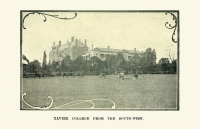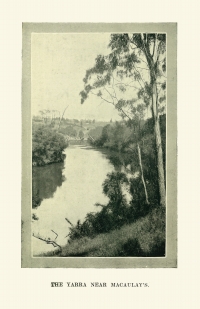In the Beginning.
That white men trod the slopes of Studley Park in the days when George the Third was King will hardly be credited by some readers of this little volume, but such is nevertheless a fact, as my story will presently show. But perhaps it may in the meantime be advantageous to briefly recount the progress of discovery in this part of the world. Though, as is now well known, Captain Cook was not the first European to set foot on the island continent of Australia, he is generally credited with being, at any rate, the discoverer of the eastern coast, which he sighted at what is thought to be the present Cape Everard, called by him Point Hicks, on 19th April, 1770. He voyaged up the eastern coast, taking (possession of it in the name of Great Britain, an in due course returned to England.
Cook's discovery created little stir, for England was engaged with the American colonies in the War of Independence. Later, when peace came, and the want of a place to which England might transport its convicts arose, Australia, then known as hew Holland, was chosen, and on 26th January, 1788, commemorated in Foundation Day, the "First Fleet," as it was called, anchored in Sydney Cove. «2»
Governor Phillip, after whom our noble bay, Port Phillip, is named, was in command, and his selection as Governor proved a wise choice. One of his officers was Lieutenant King, who afterwards (1800) became Governor of the colony himself, and a descendant of whom, Mr. Arthur S. King, of Medford, made his home in Kew.
 |
A historic Spot-Dight's Falls in 1875. |
During King's governorship, Bass and Flinders made several voyages of discovery in boats or small vessels, the latter entering Port Phillip Heads in the "Investigator" on 26t April, 1802; not, however, the first European to enter, as Lieutenant Murray in the "Lady Nelson" entered ten days previously. Flinders's report on the character of the country around Port Phillip was so favorable that Governor King determined to send a party to explore and report on it more fully, with the idea of forming a convict settlement if suitable for that purpose. Thus it happened that Charles Grimes, the acting Surveyor-General of New South Wales, and a small party set sail from Sydney in the "Cumberland," and arrived off what is now Sorrento on 20th January, 1803.
Here Grimes commenced a systematic investigation of the shores of Port Phillip, and on Wednesday, 2nd February, was the first white man to see the Yarra. The party spent several days about the present site of Melbourne, then on Monday, 7th February 1803, started in a boat up the Yarra to see where it would lead them. The first day they reached a spot somewhere about Hawthorn Bridge; on the following day, 8th February, 1803, they found their progress stopped by the obstruction now known as Dight's Falls, and landing, examined the country, being thus the first white men to tread Studley Park.
 |
Xavier College from the South-West. |
The report of Grimes' survey, after perusal by Governor King, was put away and forgotten, and it was not till more than seventy years after that it was discovered by Mr. J. J. Shillinglaw, F.R.G.S.,«3» and published by the Victorian Government. Perhaps the following extracts from the journal kept by Mr. James Fleming, one of the party, whose duty it was to report on the agricultural possibilities of the country, may be of interest. Modern names are inserted in parentheses where necessary:-
"Monday, 7th (February, 1803).-Early in the morning the party that went up the river before with the doctor, went up the little hill (Batman's Hill) we had been at on the 4th, where we stopped to breakfast. Proceeded on to a creek (Gardiner's Creek), where we dined. Saw some natives. The land is in general a fine black soil ten to eighteen inches deep. Timber-gum, banksia, oak, and mimosa of all sorts, but not large except the gum. The river appears to rise to the height of eight or ten feet at times by wreck on the trees. Went alternately into the land on both sides of the river; it continued nearly of the same quality. The greatest part of the land is above the flood. Proceeded on till sunset; stopped the night."
"Tuesday, 8th.-Sowed some seeds by the natives' hut where we slept. Continued our course up the river; the land high; rock by the side of the river; it is freestone, the strata on edge. Came to a fall (Dight's falls) where we could not get the boat over. We went inland a little way. It is stony, about six inches black stiff soil, white clay at bottom. Mr. Robins got up a tree; saw it to be gently rising hill clothed with trees for ten or fifteen miles. A little above the fall there is a small island, and] the river divides in two. The timber in general is gum, oak, and banksia; the two latter are small; the gum two to four feet diameter, and from ten to thirty feet high; on of the low ground they are something larger. We were not more than half a mile from the river. Returned back and crossed a neck of land, 330 paces over (Studley Park, near Johnston Street Bridge), while the boat went round. . . ." «4»
 |
Walmer Street Ferry. Victoria Bridge. |
Thus is worded the first description of any part of Kew, and from that day can Kew fairly claim to commence its history.
Grimes' report was so favorable that Governor King recommended the British Government to despatch a consignment of convicts to Port Phillip, and form at new settlement there. Fortunately for Victoria, Collins, who was in command, attempted to make the settlement near the Heads, where, owing to the absence of good supplies of fresh water, the expedition was soon in difficulties, and later Collins and his convicts abandoned Sorrento and sailed for Hobart in January, 1804.
We hear nothing of exploration in Victoria for many years, till Hume and Hovell fought their way through the thick forests of the Plenty Ranges in December, 1824, and reached the sea at Corio Bay.
The next invasion of Southern Victoria was that by John Batman, of Launceston, who is thought to have made his famous treaty with the natives on the Merri Creek within sight of the heights of Studley Park, on 6th June, 1835, and two days later, as he viewed the pleasant surroundings of the falls which formerly existed at Queen's bridge, Melbourne, uttered that prophetic remark-"This will be the place for a village."
Meanwhile another family, whose name has been familiar to residents of Kew for nearly fifty years, the Henty family, had started a settlement at what is now known as Portland Bay. Here Thomas Henty, with some of his sons (Stephen George, Edward, and Francis were afterwards residents of Kew), landed on 19th November, 1834.
 |
The Yarra near Macaulay's. |
Fawkner and his party soon followed Batman, and by the end of 1835 Melbourne had really been established. Soon the capabilities of Port Phillip became known in Sydney and in Tasmania, and adventurous spirits arrived to take up the land, sheep being imported from Tasmania in great numbers. «5»
The first mob of cattle was driven overland from New South Wales, and arrived near the settlement in December, 1836. The owners, John Gardiner, Captain John Hepburn, and Joseph Hawdon, crossed their cattle over the Yarra at Dight's Falls, and founded, in what is now Kew an Hawthorn, the first cattle station in Australia Felix. We can easily picture the joy they must have felt when settling down amid such delightful surroundings as the wooded hills and well grassed dales of Kew and Hawthorn, that their long journey was ended. Gardiner soon bought his partners out, and built a little homestead on the banks of the creek generally known as Gardiner's, though officially called "Koo-yong-koot"-hence the name chosen or the Federal electorate, Kooyong. Gardiner, who had been a banker in Launceston, did not long remain a Boroondara squatter, moving up country towards what is now Lilydale. In 1839 he forsook squatting and became manager of the Port Phillip Bank; soon after he. was sent to England to obtain further capital, but did not return. «6»
 |
 |

